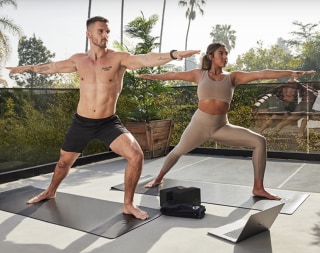
How Alo Moves inspired me to try new at-home exercise classes
After using the virtual fitness platform for months, it’s become my favorite way to workout at home and has inspired me to try different exercise classes.




You need an internet connection to access Alo Moves workouts, or you can download classes to play them offline. I prefer to use Alo Moves’ app to take classes, but you can also log into your account on a web browser.
The platform’s interface is simple and user-friendly. To browse classes, you can filter by duration, workout type and style, difficulty level, intensity and instructor (I’ve grown to gravitate towards a few instructors, so I find this option useful). Some classes are one-off workouts while others are part of a series, meaning they’re connected around a theme like cardio, or a general goal like improving flexibility. You can save classes and series to the “your practice” section of Alo Moves, which is a collection of your bookmarked workouts.
After each class, you have the option to log your workout. I use the log as a way to keep track of the classes I’ve taken in case I want to revisit any in the future. You can also add comments to classes and review them so others can read about your experience.
Alo Moves’ classes are all different lengths, which is one of my favorite features about the fitness platform. If I have more time during the week or when I’m not rushing on the weekend, I can enjoy a longer 40- to 60-minute class. But if I’m pressed for time, I choose a class that’s between 10 to 30 minutes. Sometimes I’ll take shorter classes during a lunch break, and I even did some between shifts covering Amazon Prime Day this year.
Sometimes I’ll also take two or three shorter Alo Moves classes in a row — for example, I’ll do a 10-minute class focused on biceps and another 10-minute class for triceps. This gives me the flexibility to choose which muscle groups I want to focus on. I make workout playlists through Alo Moves with a few of the shorter classes I enjoy taking together so I can keep track of them and the order I did them in.
What I’ve found most surprising about Alo Moves is how engaging the classes are. Despite sessions being recorded, instructors make it feel like they’re teaching you live or are with you at home. They also offer modifications — for example, a barre instructor may tell you how to do an exercise standing instead of on your knees if you have arthritis. The classes are designed to be accessible for everyone, and instructors tell you how to make a workout more or less intense depending on your fitness level.
While many Alo Moves classes can be done without equipment, I’ve found a few items to be particularly useful. I add my beloved Bala Bangles to most workouts, and I keep a heavier and lighter set of dumbbells nearby. Some classes also utilize resistance bands, pilates balls, pilates rings, yoga blocks and sliders. I do all the workouts on a yoga mat, as well.
When I first joined Alo Moves, I only took classes I was familiar with: barre, pilates and yoga. But after a few weeks of using the platform, I started scrolling through weight lifting and HIIT classes, which I’d never tried before. Since I was at home, I realized that no one would see if I didn't do an exercise correctly, lost my balance or had to lie down on my yoga mat after a particularly challenging cardio series. This motivated me to try workouts I most likely wouldn't have if I had had to attend in-person classes. I discovered that I really enjoy a range of classes and now make an effort to do a handful of different ones during the week.
If you’re deciding what virtual fitness platform to try, below are a few other options that are similar to Alo Moves.
obé Fitness offers similar classes to Alo Moves, like cardio, strength-based programs, yoga and more. The biggest difference between the platforms is that obé streams live classes every day in addition to its library of recorded classes. You can track classes as well as download and save ones to take when you don’t have internet access. An obé subscription costs $27 per month or $199 per year, or you can purchase a quarterly subscription for $65 per year.
Even if you don’t have a Peloton bike or treadmill, you can download the company’s fitness app, which offers the same variety of classes as Alo Moves and obé that you can do with no equipment. The app also has running, walking and cycling classes. You can subscribe for $13 per month and the app is available to download on phones, tablets, computers and TVs.
Catch up on Select's in-depth coverage of personal finance, tech and tools, wellness and more, and follow us on Facebook, Instagram and Twitter to stay up to date.